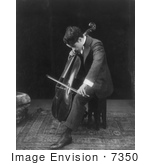
Dorothy Edwards’ single novel, Winter Sonata (1930), much admired by David Garnett, was meant to model itself on the musical sonata form. Having spent many hours once upon a time with a pencil and sheaves of music, parsing the harmonic progressions and the form’s variations, I tried to engage the novel with musical analysis. (Not for long; it is too metaphorical a comparison.)
This isn’t a long novel, nor is it dramatically complex. Arnold Nettle has gone to winter as a telegraph clerk in a small village for his health. He plays the cello and it is because of his cello that he is invited to visit the home of Eleanor and Olivia Neran, two beautiful neighborhood girls living with their aunt Mrs. Curle and portly pseudo-philosophical cousin George. Nettle is vaguely in love with Olivia, having seen her through a window, though he cannot seem to gather enough strength or courage to continue an ordinary conversation – with anyone.
Nettle lives in the village with a landlady and her daughter, Pauline, whom the landlady calls a slut, or in company “flighty.” Pauline is somewhat aggressively flirtatious and her laughter unnerves Nettle. The small circle of villagers is extended when Mr. Premiss, a friend of George’s, a “very distinguished critic, quiet famous,” and something of a vague flirt, comes to stay with the Nerans.
This is a novel without much conflict. The characters seem to be wandering in their own orbits of unexplainable sadness, loneliness, solitude, and the thoughts which cushion them from each other. When Olivia, Eleanor and George walk together, depression soon sets in and they walk, arm in arm, lost in their individual half-articulated thoughts.
Mr. Premiss tells Eleanor that flirting is the thread that sews people together:
“…in this world we poor mortals stand alone, rather far from each other, and it is not altogether easy for us to met. But when one makes love a little – not too much – it is like sending little messengers out to communicate with each other. If you were ever so kind as to condescend to flirt with me, it would be like a little white dove flying towards me,” he laughed. “And I should send to you – what bird do you think I should send?”
“A kingfisher,” she said spontaneously.
Nettle is to be pitied, of course. He is fragile, physically and emotionally, and he is unable to contribute to discussions or to summon enough strength to make the most of social visits. His shyness restrains any natural communication, and the reader is aware of his jubilance in visiting the Nerans and their unease with his awkward and agitated silence.
It seems as though Edwards spent more words on the physical makeup of the village and the seasons as they passed from the last day of autumn (“the sun shone quite warmly through the clouds, but the earth had already hardened itself for winter, and did not respond”) to the first heralding of spring (the tips of snowdrops). She repeats several words and images like firs, hard earth, black branches, grey skies, red suns/ sunsets/ sunrises, rain, the grey church spire, and I couldn’t decide if this was an emphasized depiction of the monotony and melancholy of winter, or if this was to act as the musical themes of the “sonata” which continued to bind the work together.
There’s nothing I like more than an appropriate read. Though it is spring and – what’s more – Holy Week, Seattle is a frozen tundra of cool and wuthering winter winds and slanting rain. This weather and Yo Yo Ma’s cello have brought Winter Sonata to life in my little room.
Happy Holy Saturday. May the world spring back to life tomorrow.
Comments